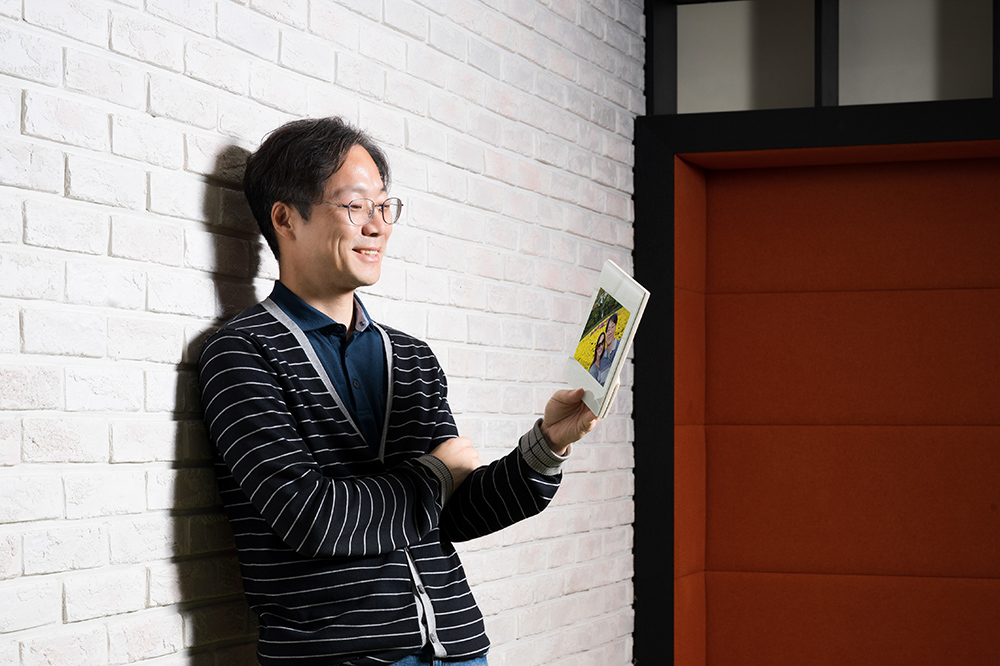Spring 2013, Period of Devotion to Semiconductor Development

In 2013, there were some people at SK hynix who were working hard to make a masterpiece semiconductor product that would serve as a main source of revenue in the long term. One of the key people was Seon Soon Kim, Head of DRAM PI (Process Integration), who was performing jobs related to the PI for DRAMs at that time.
After working in Wuxi, China from 2009 to 2012, Kim returned to the headquarters in 2013 and joined a new DRAM development project. At that time, Kim was a member of the PI Part involved in the overall manufacturing process from core development to yield increase (ramp-up) after the mass production transfer and later took a new task, the development of 20-nano-level 8Gb DDR4. Kim was put into full-scale development work, with the device engineers who worked with him at that time in the DRAM Device Product Development (PD) Team of the DRAM Device Group.
“At that time, IT technology was developing very rapidly. Accordingly, the need for high-speed, high-density, and low-power products began to emerge in the IT industry. Among them, the need for high-density and high-speed products was particularly great. Therefore, we judged that the DDR4, which reduces power consumption while increasing the speed for high-capacity 8Gb products, would be very competitive.”
To develop the 20-nano-level 8Gb DDR4, several hardships had to be overcome. First, a 2Ynm process technology, which is more advanced than the existing 2Xnm process technology, was necessary to be developed. At that time, the company’s competitor had already optimized the 2Ynm process technology. The process of securing 8GB capacity was not easy. The only thing that the project team members could do in such a situation was to do their best with tenacious devotion to their job.
As a member of the project team, Kim’s days at that time were also busy, without a break. He usually liked to hike or walk in a park with his family to enjoy the natural views, but he couldn’t have any time for relaxing and enjoying himself in the spring that year. For him, the only time for enjoying the season was when he was taking a short walk or relaxing for a few minutes, listening to a song in the office.

“In springs, I had my own routine of walking on various hiking trails for enjoying different flowers each time. During the project, however, I was so busy that I had to take a short walk listening to the song instead. Even now, in spring, whenever I listen to the song that I used to listen to, it brings back the memory of that time, reminding me that I have overcome those days well. Along with the song, my family and colleagues were around me, so I was able to do my best to develop the DRAM until the end without getting tired.”
Development of the World’s First Ultra-High-Capacity 128GB DDR4 Module Opens a New Horizon in the IT Industry
The product that was born through the commitment despite numerous difficulties is the world’s first ultra-high-capacity 128GB DDR4 module based on 2Ynm 8Gb DDR4. As a derivative of 2Ynm 8Gb DDR4, this product realized the maximum level of capacity, doubling the highest capacity existing at that time, which was 64GB.
To realize the maximum capacity, a Through Silicon Via (TSV) technology was first applied to mass production. This is a technology that transmits commands and data by stacking DRAM chips vertically and creating a column-shaped movement path through the entire layers. As a technology that can replace the existing wire bonding, which connects wires to the outside of a chip for signal transmission, it dramatically reduces the distance between chips or the distance from printed circuit board (PCB). This not only enabled high-speed and low-power communication, but also stacking with over a double number of layers.
As a result, when comparing to the previous generation DDR3, the specification has improved more than twice. The capacity has been doubled from 64GB to 128GB. The transmission speed was upgraded from 1,333Mbps to 2,133Mbps, and the operating voltage was also decreased from 1.35V to 1.2V.
This product surpassed technical limitations by developing a process technology and applying the TSV technology, and it played a huge role in helping SK hynix become the key player of the server market afterwards. This was because this product satisfied all different needs in the server market, such as needs for products with high-density, high-speed, and low-power. For SK hynix, it was a turning point where it made customers aware of the fact that SK hynix was capable of proactively responding to the server market.
Just like the spring representing a new start and change, the 128GB DDR4 module presented another spring to SK hynix. One of its developers, Seon Soon Kim, is now taking a very active part as a leader of the DRAM business based on his achievements. What does a 128GB DDR4 module mean to him?

“For me, the 128GB DDR4 module means ‘the beginning of change’. There have been many personal changes since the development of this product. As my position at work changed, the form of work also changed. When the company implemented new projects, I always actively participated in them. I think I’ve been able to enjoy changes without missing an opportunity and actively respond to those changes. The world is changing rapidly. If we stay the same, it will be impossible to move forward, neither at a personal level nor at a company level. Just like the 128GB DDR4 module opened a new era, I hope that the members at the company also voluntarily bring and enjoy changes and become the key people of the world to come.”










